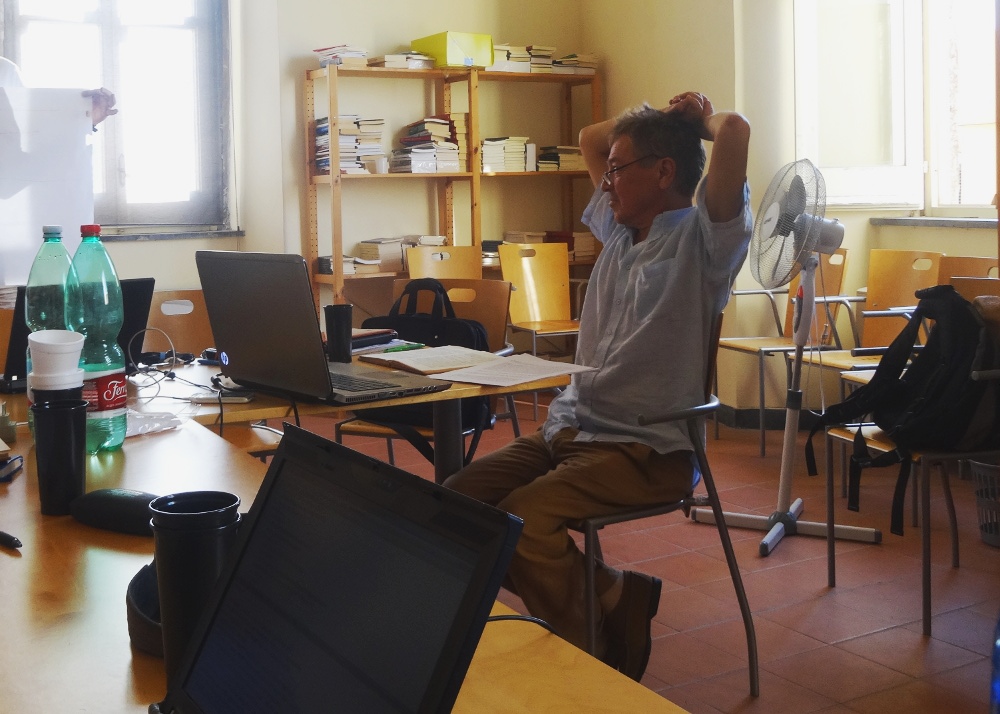…or can one just say that his existence cannot be denied?
During his commentary on Maṇḍana Miśra’s Vidhiviveka (henceforth VV), 1.14–15, Vācaspati Miśra focuses on the possibility of the existence of omniscients. Why so? Because the VV is a Mīmāṃsaka text and the whole Mīmāṃsā enterprise depends on the idea that the Vedas are the only way to know about dharma. Thus, the existence of omniscient being, who would have direct access to dharma, would automatically invalidate the Mīmāṃsā epistemology. Consequently, the VV and its commentary need to stage from the beginning a debate between a Buddhist Pramāṇavādin (favouring omniscients) and a Mīmāṃsaka (denying them). During his commentary on VV 1.14, the last word is left to the Pramāṇavādin and Vācaspati seems to display some familiarity with Pramāṇavāda material, since he quotes from Dharmakīrti and discusses the existence of concrete omniscient beings (such as the Buddha), rather than the abstract possibility of yogipratyakṣa*. Part of the discussion is agreeable and well-structured:
- The omniscient one exists
- Because there are no means to deny his existence and because there are means to positively establish it
- Discussion of the former, featuring sense perception and then inference
- Discussion of the latter, featuring sense perception
The discussion of 3. is rich and interesting, with the Mīmāṃsaka arguing for the necessity of desire for communication (this is Kumārila’s position) and the Pramāṇavādin replying that the compassion which moves the Buddha to help others is not a desire (rāga). A more technical discussion about the impossibility to formalise a syllogism denying the omniscient is also present.
The odd point about the discussion, however, comes after it, at point 4, since Vācaspati does not seem indeed to give any positive motivation for the existence of an omniscient one (although he promises that he will discuss it again later —I do not yet know whether he keeps his promise). Accordingly, the discussion of 4. is also negative in nature:
Nor is it the case that there are no positive evidences. To elaborate, such an [absence] should be either absence of perceptual [evidence] or of [evidence] from all (other?) instruments of knowledge. In turn, the absence of perceptual [evidence] regards either itself or all [the rest]. Even if it regards itself, then it can be either characterised by the fact that [the absence of perception regards] something perceptible, or [the absence of perception] is not characterised (by either perceptibility or anything else). To begin with, the absence of perceptual evidence of itself as regarding something perceptible does not prove the absence of an omniscient. Because the [omniscience] has a remote (i.e., parokṣa) nature and, thus, cannot have its [perceptual] reality arise, as it is well known. And the absence of the whole sense-perception is not established, because the [absence of perceptual evidence] which is not [further] characterised is wrong. For, it is not the case that the entire perception of a normal (i.e, not omniscient) human being (arvāgdṛś-) is absent, for this is not established.
(nāpi sādhakapramāṇābhāvaḥ. tathā hi sa pratyakṣābhavo vā sakalapramāṇābhavo vā syāt. pratyakṣābhāvo’pi cātmanaḥ sarveṣām vā yadātmanaḥ tadāpi dṛśyatāviśeṣaṇaḥ nirviśeṣaṇa vā. na tāvad ātmapratyakṣanivṛttir drśyatāviśeṣaṇā sarvajñābhāvasādhanī, tasya svabhāvaviprakarṣinas tattvānupapatteḥ prasiddhatvāt. nirviśeṣanāyāś ca vyabhicārāt samastapratyakṣanivṛtteś cāsiddhatvam. na khalv arvāgdṛśaḥ sakalapratyakṣanivṛtti asiddhatvāt, Stern p. 457.)
nirviśeṣaṇa possibly refers to sorts of perception which do not need a perceptible object, such as intellectual intuition (yogipratyakṣa).
Do you have any experience with a nirviśeṣaṇa ātmapratyakṣābhāva? And more in general, are there positive arguments for the existence of an omniscient?
*I am currently reading this text with Marco Ferrante and Cristina Pecchia. I owe this last comment to her, whereas I probably owe to Marco almost all the rest. I never write it in my articles, but just in case: All errors remain mine.
(cross-posted on the Indian Philosophy Blog)

